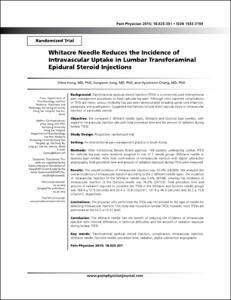KUMEL Repository
1. Journal Papers (연구논문)
1. School of Medicine (의과대학)
Dept. of Anesthesiology & Pain Medicine (마취통증의학)
Whitacre Needle Reduces the Incidence of Intravascular Uptake in Lumbar Transforaminal Epidural Steroid Injections
- Alternative Author(s)
- Hong, Ji Hee; Jung, Sung Won; Chang, Hyuk Won
- Journal Title
- Pain Physician
- ISSN
- 1533-3159
- Issued Date
- 2015
- Keyword
- Transforaminal epidural steroid injection; Complication; Intravascular injection; Whitacre needle; Quincke needle; Procedure time; Radiation; Digital subtraction angiography
- Abstract
- Background: Transforaminal epidural steroid injection (TFESI) is a commonly used interventional
pain management procedures to treat radicular leg pain. Although most reported complications
of TFESI are minor, serious morbidity has also been demonstrated including spinal cord infarction,
paraplegia, and quadriparesis. Suggested mechanisms include direct vascular injury or intravascular
injection of particulate steroid.
Objective: We compared 2 different needle types, Whitacre and Quincke type needles, with
regard to intravascular injection rate with total procedure time and the amount of radiation during
lumbar TFESI.
Study Design: Prospective, randomized trial.
Setting: An interventional pain management practice in South Korea.
Methods: After Institutional Review Board approval, 149 patients undergoing lumbar TFESI
for radicular leg pain were randomly assigned to one of 2 needle groups (Whitacre needle or
Quincke type needle). After final confirmation of intravascular injection with digital subtraction
angiography, total procedure time and amount of radiation exposure during TFESI were measured.
Results: The overall incidence of intravascular injection was 10.4% (28/269). We analyzed the
overall incidence of intravascular injection according to the 2 different needle types. The incidence
of intravascular injection of the Whitacre needle was 5.4% (8/146), whereas the incidence of
intravascular injection of the Quincke needle was 16.2% (20/123). Total procedure time and
amount of radiation required to complete the TFESI in the Whitacre and Quincke needle groups
was 168.4 ± 57.9 (seconds) and 33.4 ± 15.9 (cGy/cm2), 131.9 ± 46.0 (seconds) and 33.2 ± 15.8
(cGy/cm2), respectively.
Limitations: The physician who performed the TFESI was not blinded to the type of needle for
detecting intravascular injection. This study was focused on lumbar TFESI, however, most TFESIs are
performed at the L4-5 or L5-S1 level.
Conclusion: The Whitacre needle had the benefit of reducing the incidence of intravascular
injection with minimal differences in technical difficulties and the amount of radiation exposure
during lumbar TFESI.
- Department
- Dept. of Anesthesiology & Pain Medicine (마취통증의학)
Dept. of Psychiatry (정신건강의학)
Dept. of Radiology (영상의학)
- Publisher
- School of Medicine
- Citation
- JiHee Hong et al. (2015). Whitacre Needle Reduces the Incidence of Intravascular Uptake in Lumbar Transforaminal Epidural Steroid Injections. Pain Physician, 18(4), 325–331.
- Type
- Article
- ISSN
- 1533-3159
- 파일 목록
-
-
Download
 oak-2015-0256.pdf
기타 데이터 / 260.29 kB / Adobe PDF
oak-2015-0256.pdf
기타 데이터 / 260.29 kB / Adobe PDF
-
Items in Repository are protected by copyright, with all rights reserved, unless otherwise indicated.